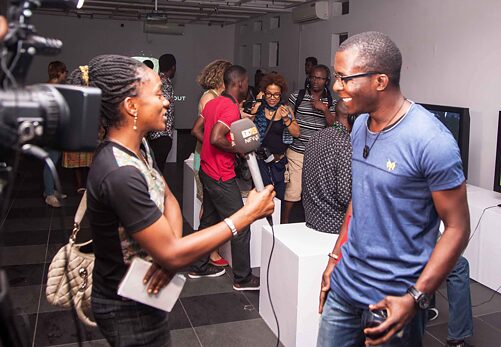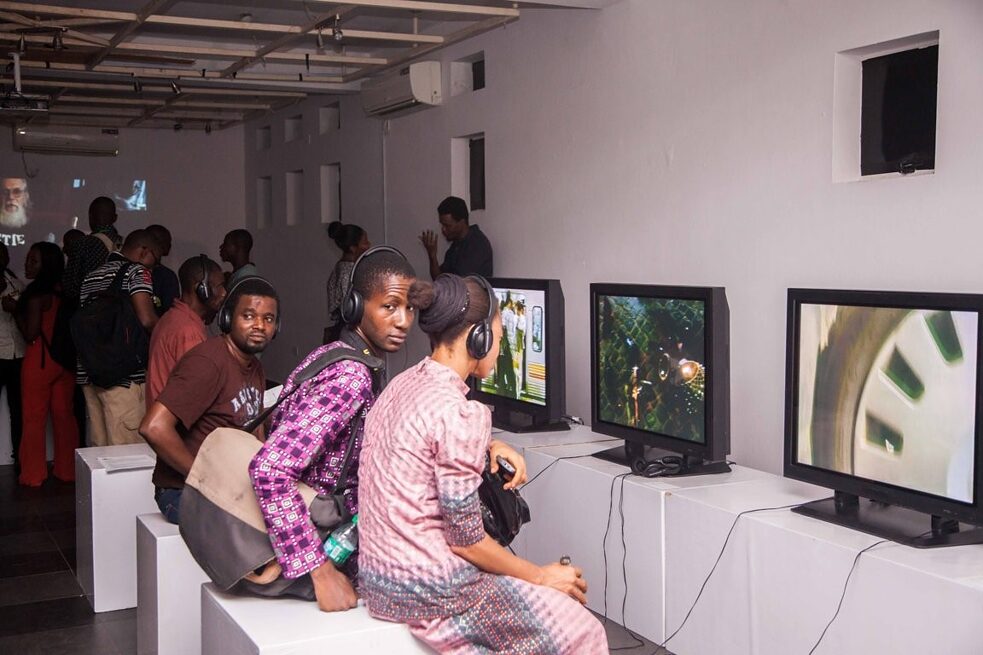Video Art In Nigeria
The formal inception of video art was in 2007 through the workshops by the Amsterdam-based One Minutes foundation in Enugu and the CCA (Centre for Contemporary Art) in Lagos. Before this time, Erasmus Onyishi, a student of Prof. El Anatsui, was already experimenting with video works in the university town of Nsukka. The workshop by the German artists Constanze Fischbeck and Daniel Kötter, in 2010 at the Goethe-Institut, Lagos, focused on video art as a means of documenting forms of fiction in urban areas. It focused on video art as a means of documenting forms of fiction in urban areas. The most important for me as a video artist was the 2009 Linha Imaginária workshop which was facilitated by the Brazilian photographer Eustáquio Neves, the late Goddy Leye from Cameroon and Miguel Petchkovsky from Angola but based in Amsterdam. We had the first international video art exhibition at CCA Lagos in 2009 curated by Oyinda Fakeye and myself.
Also as a result of our involvement in previous workshops as project coordinators and participants, Oyinda Fakeye, Emeka Ogboh, and I, thought it was important to sustain the emerging consciousness in video art in Lagos. So the three of us came together and started the platform, VAN Lagos (Video Art Network Lagos). We are trying to see how much we can expand the idea and the interest in video art in Nigeria through our activities. Aside from the exhibitions we have also run workshops in Brazil, Ghana and Sudan. Recently, in Indonesia, during the Biennale Jogja XIII (2015), which I co-curated, we had an workshop with video artists from Indonesia and Nigeria. We are also looking out for other African countries like Cape Verde, São Tomé and Príncipe, Madagascar, etc, that really want to connect with the global tendency of new media art. We’d also love to move into more local institutions and are happy to extend these workshops, if we are supported, to art schools in Nigeria.
How would you describe the debate on video art in Nigeria?
The debate on video art is not as vibrant as it should. VAN Lagos, CCA, the Goethe-Institut, African Artist Foundation and Omenka Gallery are some of the institutions that are open to this art form. In general, the consciousness about video art is rather low. Between 2009 to date, we have been able to get many Nigerian artists living within and outside the country to be part of our projects. We’ve also taken some of the video screenings to communities outside of this city, to the academic institutions such as Yaba College of Technology and University of Lagos, and to local communities in Bariga and the Freedom Park. During these interventions, some of the workshop participants had their shootings on the streets of Lagos. So people stopped and asked: – What is happening? – Oh artists. Nollywood? – No, experimental video art. – What is that? – OK. Some stayed to watch and they had fun. For us, it is more about the young people that get influenced and take on this as a considerate option to get creative rather than opt for crime. This is the impact that we aim for.
In your view what are the main influences on Nigerian video art?
Apart from the traditional art forms painting, sculpture, graphic and textile design we also have a very vibrant film culture, Nollywood. All this goes in line with an equally vibrant and expanding urban environment. We live in a city that constantly inspires by its sound, movement, colour, smell and natural components. All of these fuse intensely in a piece of space. Just open your door or window there is a waiting painterly, sculptural and material composition...there is Lagos! Now the question is: How do all these intensities and vibrations complement or relate to each other and influence effectively? Basically, the environment knocks off any sense of creative stagnancy and enhances the potentials to reason widely. Since 2009 we could create an impressive archive of experimental videos from this fusion of elements that characterise Lagos and Africa at large.
What possibility do you see for video artists to start a dialogue with Nollywood?
We cannot continue to remain in isolation, but we need to think and work ahead. So it is important for us to find a way to connect to the existing cultural and academic institutions. Nollywood is an amazing part of our culture. It is an idea that single-handedly brought itself to its present and enviable position in the film world. This is a very positive influence for us as video artists. Yes, I understand the film industry is a highly capitalist venture. It is highly commercial. But again, we have to see how we can together. I am looking forward to collaborating with Nollywood and referencing its contents. Nollywood has got the technical facilities to help the compilation of video art works over time. So we need to work together to have a compact content that can bring the change we desire, we need.
From your standpoint as a curator and video artist, what is the attraction of working with the concept of “Changing City – Shifting Spaces” in the Videonale in Lagos, 2016?
“Changing City – Shifting Spaces”
When we articulated the idea of this project, we were looking at the space – not just being the physical or geographic space, but how we connect to each other. The cities in today’s global space are really becoming dynamic. As a result of growing capitalist interests, low residential buildings are being knocked down and high-rise office structures are taken their place. In Lagos, for example, the Bar Beach’s been sand filled for a new city called Eko Atlantic. The same is happening globally with migration and refugeeism, both as a result of destabilisation in the society. Space in other context, could be spiritual, psychological and intellectual dimensions; it could be utopic, the imagined. How do we redraw our landscape? How do we redraw our artscape? How do we redraw our psychological space that we all live in? These are the questions that I discussed with the project partners Dr. Nicola Müllerschön, Tasja Langenbach, Jennifer Gassmann, the Goethe-team, Bisi Silva and the VAN Lagos team. So we thought it was quite timely and important to see how this content can impact on the landscape here and create a new form of discourse. I am pleased that we are having this rare collaboration between, particularly, Nigerian and German artists on the platform of video art.
Workshops play a leading role here in introducing video art to artists. Can you tell about the workshop led by the Anglo-Ethiopian artist Theo Eshetu during the Videonale in Lagos?
For most of the participants in this 10-day workshop, it was the first time they encountered video art. To calm their anxiety and enhance their interest, we said: ‘You don’t need to have a background in video art, but a background in other artistic processes is important’. Theo was able to strategize different stages of engaging with the 15 participants from theoretical discourses and practical exercises to intense sessions in the conceptualization and realization of an idea. Of course the availability of technical equipment was a challenge, but the participants’ dedication, discipline and commitment was encouraging. As video artist they were challenged to move the camera for an intervention with the people. When you go and establish a relationship, the people make it possible for you to realize your ideas. It is not only about “changing city and shifting spaces”, it is also about negotiating these changes and shifts.Many of the videos of the workshop carry strong social messages…
The messages from the videos express the wishes and desires of young people in our society. We are often quick to judge young people by their mistakes, but we never ask of other alternatives that can be made available to them to engage positively with their challenges. It is important for us to see the role of video art as a considerate choice for young creatives to engage their community and to share their problems and opinions with the wider society. Video art is a strong social messenger. If we do not understand these structures, the only thing that comes to our mentality is the urge for condemnation. There is the need to allow people to be heard.Jude Anogwih: “ItoredownthecitiesIdrew”, 2015, realised during the video art workshop in Jogja: “This body of work deconstructs modern spaces and encourages you to re-imagine your cities and reconstruct it with less money and segregation but more understanding and communality. Do it!”


